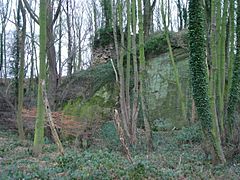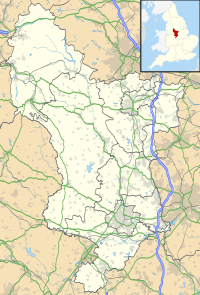Horston Castle facts for kids
Quick facts for kids Horston Castle |
|
|---|---|
| Amber Valley, Derbyshire | |

Horston Castle (2007)
|
|
| Coordinates | 52°59′05″N 1°26′34″W / 52.98483°N 1.44288°W |
| Site information | |
| Condition | ruined |
| Site history | |
| In use | C12-C14 |
| Official name: Horsley Castle tower keep castle | |
| Designated: | 31 October 1962 |
| Reference #: | 1009293 |
Horston Castle, also known as Horsley Castle, is an old ruined castle in Derbyshire, England. It's located about one mile south of the village of Horsley. This is about five miles north of the city of Derby.
Today, Horston Castle is a protected historical site. It is listed as a Scheduled Ancient Monument. However, in 2018, it was placed on the Historic England's Heritage at Risk Register. This means the castle is in poor condition and needs help to be preserved.
Contents
Horston Castle: A Glimpse into the Past
Who Built Horston Castle?
Horston Castle started as a Norman castle. It was a type called a "motte and bailey" castle. This means it had a large earth mound (the motte) with a wooden tower on top. Below the mound was a fenced area (the bailey). Ralph de Buron was the person who first built this castle.
Changes and Additions to the Castle
Later, in the 13th century, King John made big changes. He built a stronger castle using stone. He added a large central tower called a keep. He also built a chapel for prayers, a gatehouse to control who entered, and a barbican. A barbican was an extra fortified gate to protect the main entrance.
Horston Castle's Owners Over Time
In 1514, King Henry VIII gave the castle to the Duke of Norfolk. This was a reward for the Duke's help in battles against the Scots. After some time, the castle became the property of the Stanhope family.
What Happened to Horston Castle?
Today, Horston Castle is mostly in ruins. A lot of the damage happened because of extensive quarrying nearby. Quarrying is when stone is dug out of the ground. This activity likely weakened the castle's foundations.
You can still see some parts of the old keep. However, much of it is now covered by plants and trees. It's a reminder of a long-ago time in English history.


